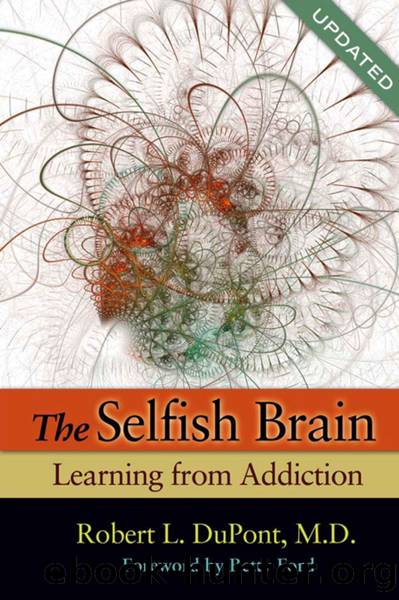The Selfish Brain by Robert L Dupont

Author:Robert L Dupont
Language: eng
Format: epub
Publisher: Hazelden Publishing
Hitting Bottom
The stage of being hooked is open-ended in the sense that addicts do not outgrow addiction or get tired of it. Addiction is not a self-curing disease. Addicts cannot learn or think their way out of it. Addiction just gets worse over time, slowly or rapidly. The next stage in the journey of addiction is hitting bottom. Addiction persists until there are painful and inescapable consequences to the alcohol or drug use. These can be negative physical or behavioral consequences. Bottoms can be medical or health problems. Often the painful consequences from addiction come from the workplace or from the law, through arrest. Today in the United States, addiction arrests are most commonly for driving while impaired (DWI), as nearly 2 million Americans are arrested each year for drunk driving.
The highest prices for addiction usually are paid in the family, but because of the workings of codependence, as described in Chapter 8, the family is seldom the place where the addict hits bottom until later in the disease. Families are, like the addict, caught up in denial, and they usually need outside help if they are to create bottoms for the addict. This is called an intervention, a process described in Chapter 10. Families create bottoms for addicted people when they conduct interventions. They can create bottoms for addicts that do not have the danger often seen in lower bottoms such as loss of career, accidents, health events, and arrests. This requires tough love and real determination. Simply saying, “We think you should stop using alcohol (or other drugs)” will not do the job.
The less the addict suffers from character disorder, the higher the addict’s bottom, meaning that less suffering is required to reach the conclusion that further alcohol or drug use is incompatible with living a reasonable life. The more there is character disorder, the lower the bottom, meaning that more painful episodes are required to convince the drug user that the use cannot continue.
A high bottom is waking up one morning and not remembering what happened last night, or having a paranoid episode as a result of smoking pot or snorting cocaine. Some alcoholics hit bottom when their physicians tell them their liver function tests are slightly abnormal. Addicts with no character disorder, especially those without relatives who are also addicted, sometimes conclude as a result of such relatively mild experiences that they should not use alcohol or other drugs any more. For people who really like to get high, which often means people with character disorder and/or a strong family history of addiction, these mild bottoms are barely noticed. They are shrugged off as minor but inescapable costs of the intensely valued pleasures of getting high.
For dedicated addicts, bottoms are often far lower. The negative consequences have to be truly terrible to get some chemically dependent people to recognize that their lives cannot continue if they continue to use alcohol and other drugs. For many addicts, severe automobile accidents, arrests, imprisonment, life-threatening health problems, family disruption,
Download
This site does not store any files on its server. We only index and link to content provided by other sites. Please contact the content providers to delete copyright contents if any and email us, we'll remove relevant links or contents immediately.
Professional Troublemaker by Luvvie Ajayi Jones(29445)
Whiskey Words & a Shovel I by r.h. Sin(19198)
Rewire Your Anxious Brain by Catherine M. Pittman(18337)
Healthy Aging For Dummies by Brent Agin & Sharon Perkins RN(16935)
Cat's cradle by Kurt Vonnegut(14804)
Talking to Strangers by Malcolm Gladwell(12916)
The Art of Thinking Clearly by Rolf Dobelli(9951)
They Both Die at the End by Adam Silvera(9520)
The 5 Love Languages: The Secret to Love That Lasts by Gary Chapman(9315)
Doing It: Let's Talk About Sex... by Hannah Witton(9094)
The Compound Effect by Darren Hardy(8543)
Thirteen Reasons Why by Jay Asher(8492)
Goodbye, Things by Fumio Sasaki(8306)
Wonder by R.J. Palacio(8281)
Atomic Habits: Tiny Changes, Remarkable Results by James Clear(8066)
Becoming Supernatural by Dr. Joe Dispenza(7869)
Tools of Titans by Timothy Ferriss(7850)
Wonder by R. J. Palacio(7756)
Should I Stay or Should I Go? by Ramani Durvasula(7440)
